The base of a bottle has a lot to say about a bottle's age. The main
feature on a base is the presence or absence of markings. These markings
can be a pontil mark, machine scar, or lettering.
The pontil types shown below are specific representations of actual
bottles. The exact
shape of the pontil or presentation of lettering on the base may very greatly.
Pontils were attached to the base of the bottle so that it could be
detached from the blowpipe and the lip could be tooled.
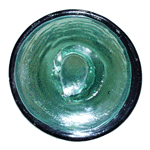 |
Open pontil base (OP), circ:
1840-1845
This base type is distinguished by a tubular scar. This pontil
is also known as a blowpipe pontil. After the blowpipe was
severed from the blown bottle it was attached to the bottle's
base . Thus the scar is the diameter of the neck. This type of
pontil was occasionally used until 1860, but was not a production technique
on beer bottles. |
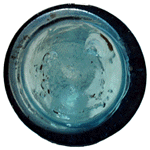 |
Scar pontil base (SP), circ: 1750-1845
This base type is distinguished by chunks of glass scarring the
bottle's base. This is also known as a sand or re-fired pontil
and is common on early black glass bottles. In the evolution of
beer bottles, the scar pontil followed the use of the open
pontil.
|
 |
Improved pontil base (IP), circ:
1844-1860
This base type is distinguished by a gray metallic residue on
the base of the bottle. This is also known as an iron pontil or
graphite pontil due to the coloration of the residue. The amount of
residue can very greatly and is many times worn off. However,
scarring will usually remain on the base, which can be felt as a
sharp indentation into the base.
There is another variation of the improved pontil with a red
coloration. These are more common of bottles manufactured in the
Mid-West. However, examples of Eastern manufacture can be
located. |
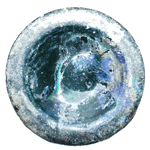 |
Snap case base (SC), circ: 1855-1865
This base type is distinguished by smooth markings left by snaps
or clamps, which were the replacements for pontils. They are
often mistaken for pontils by novice and advanced collectors.
With a pontil being a premium, this is often wishful thinking.
The best way to identify this base is to feel it. Snap case
bases are distorted but smooth to the touch. |
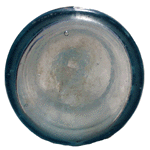
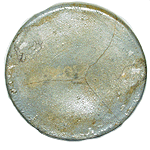 |
Smooth base (SB), glass: circ: 1857-1920,
pottery: circ: 1830-1920
This base type is distinguished by a smooth well formed base.
Often there are letters or numbers present. These can be mold
identifiers, manufacturer's markings, or the proprietor's
initials or logo. Many times the markings are double struck or
ghosted. On pottery bottles there can be impressed letters
as well.
|
 |
Concentric rings base (CR), circ:
1840-1880
This base type appears on pottery bottles and was formed when
the thrown bottle was separated from the potter's wheel. A
wire was looped around the bottle's base and crossed. As
the wheel spun, the wire was pulled and sliced the bottle off
the wheel and created a series of concentric rings on the base
of the bottle. |
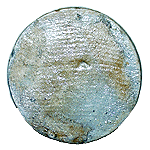 |
Sequential straight lines base
(SL), circ: 1840-1860
This base type appears on pottery bottles and was formed when
the thrown bottle was separated from the potter's wheel. A
wire was pulled across the bottle's base. |
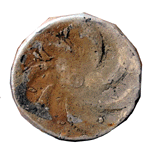 |
Pressed base (PB), circ:
1847-1895
This base type is present on pottery bottles that were not
thrown on a potter's wheel, but pressed into a mold and
then fired. They are often have a dimple in the center
and a set swirled impressions radiating from it. This style of
bottle was often manufactured in Ohio. |
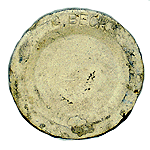 |
Molded base (MB), circ:
1885-1920
This base type is present on pottery bottles that were not
thrown on a potter's wheel, but molded in plaster molds and
then fired. They are often indented and are smooth or
can have impressed or stenciled lettering. This style of
bottle was often manufactured in Western Pennsylvania. |
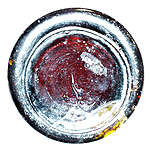 |
Automatic bottle machine base (ABM), circ: 1895-1920
This base type is distinguished by a small ridge of glass that
can travel up onto the sides of the bottle. The size of the ring
can very from half an inch to the width of the bottle. Look for
a seam line over the lip of the bottle to positively identify a
machine made bottle. Semi-automatic bottles also have these base
scars and predate fully machine made bottles by nearly a decade. |

